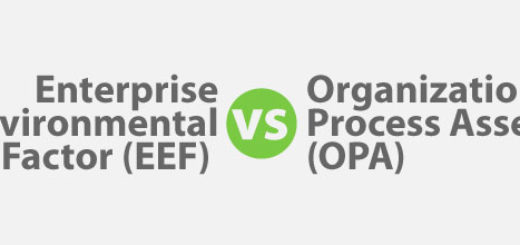Project Benefit Analysis Concepts for the PMP Exam

During project initiation, the project manager is often tasked with the responsibility to assess whether a project proposal is beneficial to the performing organization and whether the project is aligned to organization business goals. In fact, the new PMP Exam has added a new task to the PMP Exam Content Outline:
Conduct benefit analysis with stakeholders (including sponsor, customer, subject matter experts), in order to validate project alignment with organizational strategy and expected business value.
There are some metrics / accounting terms that would help the Project Manager to better assess and compare project proposals, namely:
- Payback Period
- Return on Investment (ROI)
- Opportunity cost
- Net Present Value
- Benefit-Cost Ratio (BCR)
- Internal Rate of Return (IRR)
- Depreciation
- Sunk Cost
We will discuss the first three terms in this article and leave the rest in the sequel.
Article Highlights
Payback Period
Payback Period is the time it takes for the organization to earn back the initial investment (in terms of monetary cost) to the project and begin making profits.
If the income generated from the project is constant, the payback period can be calculated using the simplified formula:
Payback Period = Initial Investment / Periodic Cash-flow
For example, if the organization need to invest US$10,000 into a project that is expected to generate US$1,000 per month, the payback period would be:
Payback Period = US$10,000 / US$1,000/month = 10 months
In the actual exam, candidates are seldom required to calculate the payback period for projects (after all, the exam is not an accounting exam). The exam inclines more on testing Aspirants’ conceptual knowledge, i.e. whether the candidate understands the meaning behind payback period or other terms.
The following would be a sample PMP Exam question on payback period:
- You are the project manager of the organization and you are tasked with the responsibility of selecting a project from two proposals A and B based on the business values with the information on hand: Project A has a payback period of 20 months while Project B has a payback period of 30 months. Which one should you recommend?
A. Project A
B. Project B
C. Neither one is beneficial to the organization.
D. Ask the project sponsor to choose.
Based on the fact that only the payback period is provided, we should rely solely on this information to make the selection. Since Project A has a shorter payback period, it is considered financially more beneficial for the organization. NOTE: since you are tasked with the responsibility, it is not appropriate for you to escalate the decision making back to the project sponsor. Project Managers are expected to should responsibilities according to PMI, though in reality it is always the senior management / project sponsor to make the project selection.
Generally speaking,
The shorter the Payback Period, the more favourable the project financially to the organization.
However, Project Managers should note that Payback Period is rarely used solely as a project selection criterion. The organization would need to consider an array of different metrics in order to selection the projec with the best value realization to the organization. common project selection criteria include:
- Return on Investment
- Cost-benefit Ratio
- Net Present Value , etc.
Return on Investment (ROI)
Return on investment (ROI) is the benefit an investment bring about, by comparing profits in relation to capital invested.
The formula for calculating Return on Investment for a project is (note that the PMP Exam does not require candidates to calculate ROI):
Return on Investment = Net profit / Capital Invested
Net profit (usually expressed as net present value [NPV]) is the total capital invested minus all expenditure. If ROI is larger than 1, the project is deemed to be profitable. If ROI is smaller than 1, the project loses money.
A sample PMP Exam question on return on investment:
- The organization is considering several projects with the following return on investment:
ROI of Project A = 1.1
ROI of Project B = 0.4
ROI of Project C = 1.8
ROI of Project D = 1.0
By judging on ROI alone, which project is the most favourable choice?
A. Project A
B. Project B
C. Project C
D. Project D
Project C has the largest ROI. If ROI is the only metric to compare, Project C would be the best project to undertake.
Aspirants would only need to remember that:
The higher the Return on Investment, the more favourable the project financially to the organization.
However, in reality, ROI is not only project selection criteria. Let’s look at the mock question above again, if we further know that Project C is such a small project that the net gain from the project is US$8 while that for Project A is US$800,000. If you are the senior management, how will you choose again? It is really difficult to tell. Other factors must be considered.
But one thing is clear is that in the exam, the questions are usually simplified enough to ask you to make the choice based on a single metric which is never the case in real life situations.
Opportunity Cost
Opportunity Cost is the value of the best alternative given up when a choice is made, in which the choices must be mutually exclusive owing to limited resources.
In simpler terms, opportunity cost is the highest value a person needs to give up for the chosen choice. For example, if you have US$10, you can either buy a coffee or 2 muffins. When you purchased the coffee, your opportunity cost is 2 muffins as you don’t have the money to purchase the muffins.
For the PMP Exam, Aspirants should only need to know that owing to limited resources (money, human, space, etc.), the organization will often need to select one project over the others. The Opportunity Cost is the single best alternative NOT chosen (NOTE: Opportunity Cost is not the sum of the values of all project given up). For most cases, the chosen project is believed to deliver the best values among all the project choices.
There is no calculation required for getting the opportunity cost.
A mock exam question on opportunity cost:
- You are the working in the PMO of your organization and there are three project proposals submitted. However, owing to the limitation of capital, only one project can be chosen. Project A would have a NPV of US$100,000, Project B would have a NPV of US$120,000 while Project C would have a NPV of US$50,000. What is the opportunity cost of choosing the project with the highest NPV?
A. US$120,000
B. US$50,000
C. US$100,000
D. US$150,000
Project B has the highest NPV and hence it is chosen. Based on the definition of opportunity cost, the second best NPV would be the best value given up. So the NPV of Project A would be the opportunity cost, i.e. US$100,000.
Most Popular PMP Certification Exam Articles
- My Exam Prep Tips and Free Resources (I got 4P and 1 MP)
- How to Get 35 Contact Hours Fast and Easy?
- Detailed Comparision of online PMP Courses
- Over 1000+ FREE Quality Mock Exam / Practice Questions
- A FREE Guide to Formulas and Calculation (with explanation and sample questions)
- 47 Commonly Confused Terms with detailed explanation




 Hi, my name is Edward Chung, PMP, PMI-ACP®, ITIL® Foundation. Like most of us, I am a working professional pursuing career advancements through Certifications. As I am having a full-time job and a family with 3 kids, I need to pursue professional certifications in the most effective way (i.e. with the least amount of time). I share my exam tips here in the hope of helping fellow Certification aspirants!
Hi, my name is Edward Chung, PMP, PMI-ACP®, ITIL® Foundation. Like most of us, I am a working professional pursuing career advancements through Certifications. As I am having a full-time job and a family with 3 kids, I need to pursue professional certifications in the most effective way (i.e. with the least amount of time). I share my exam tips here in the hope of helping fellow Certification aspirants!






“If ROI is smaller than 1, the project loses money.”
This doesn’t seem to be true; shouldn’t this say smaller than 0?
If the project has any profits, the project is technically gaining money, and the ROI may come in at say, 0.10 or 10%. For ROI greater than 1, the project must profit as much as the initial investment (1 or 100% return), and then some….
According to my understanding, ROI is the calculated by [total income]/[initial investment]. If you invest $2 and get $2 in return, ROI would be 1. If you get $2.1, ROI would be 1.05. This shows that ROI larger than 1 indicates that the project is earning a profit.
Edward,
I saw a question like this in one of the sample exams
”
Project X has a RoI of 0.2, project Y has a BCR of 1.3, project Z has a BCR of 1.1, project A has a RoI of 0.4. Which project is most suited to go ahead with?
Details for Each Option:
A
Project X
B
Project Z
C
Project A
Explanation: An RoI (Return on Investment = ((Revenue – Investment) / Investment) of 0.4 is the same as BCR (Benefit Cost Ratio = Revenue / Investment) of 1.4. Therefore project A has the maximum financial return. Note that these are not explained in the PMBOK Guide.
D
Project Y
”
I did not understand the explanation given in the response. Can you explain it in a better manner?
ROI and BCR calculation was included in PMBOK Guide 4th edition but not later. You can safely be assured that you will not be required to do such calculation in the current PMP Exam.
Wish you PMP success!
On the PMP Exam, would we be required to calculate ROI?
Hi Jane,
No worry, the PMP Exam will only need to test you if you know higher ROI or lower ROI is better. There is no need to do the calculation.
Wish you PMP success!
Edward
Your explanation and answer to opportunity cost does not seem right based on the option values provided.
Hi Cecil,
Would you please further elaborate on why you think the answer is incorrect? The opportunity cost is the value of second best option and in this case is US$100,000. So C is the answer.
Thanks!